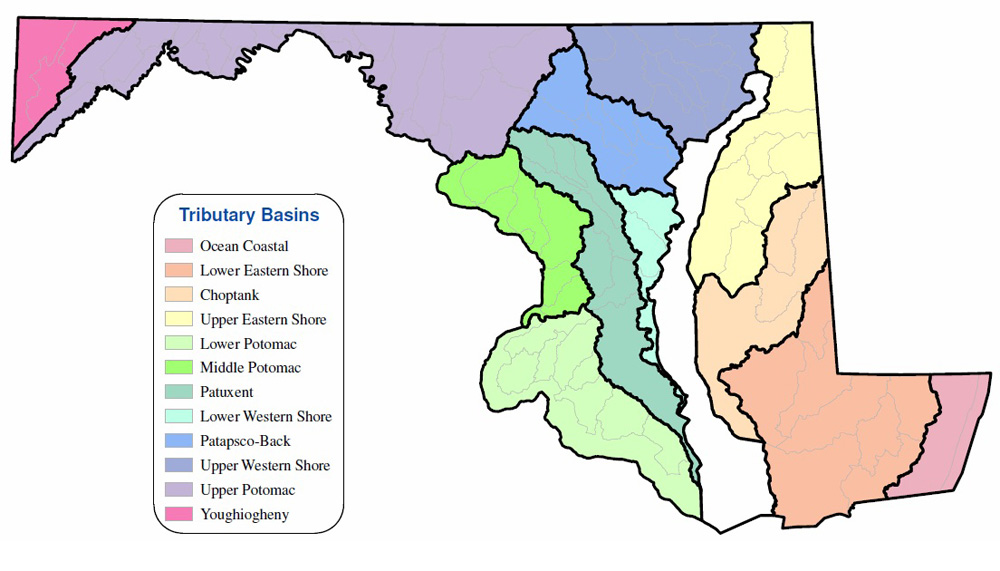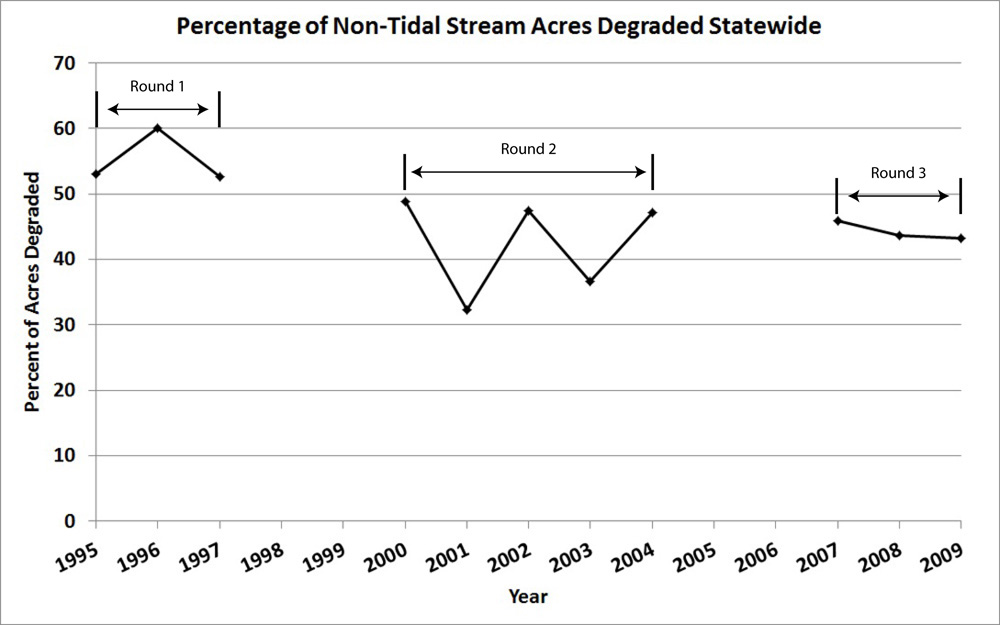Results of the Round 3 Maryland Biological Stream Survey (2007-2009)
The Maryland Biological Stream Survey (MBSS) is a statewide survey led by the Maryland Department of Natural Resources (DNR). It is a comprehensive program to assess the status of biological resources in Maryland's non-tidal streams; quantify the extent to which acidic deposition affects critical biological resources in the state; examine which other water chemistry, physical habitat, and land use factors are important in explaining stream conditions; provide a statewide inventory of stream biota; establish a benchmark for long-term monitoring; and target future local-scale assessments and mitigation measures needed to restore degraded biological resources.
Following pilot and demonstration projects in 1993 and 1994, the MBSS began its first "round" of sampling to characterize stream conditions and inventory resources statewide. While the MBSS monitors Maryland streams every year in support of multiple objectives, each statewide round of sampling focuses on random sites that provide probability-based estimates of conditions and resources with known confidence. These estimates are computed for the entire state as well as small geographic regions and watersheds. Round 1 of the MBSS was conducted in 1995-1997 and Round 2 was conducted in 2000-2004.

Click Image to Enlarge
The following paragraphs report the results of Round 3 of the MBSS which was conducted in 2007-2009. Unlike the previous rounds, which were reported as a single volume (Round 1) or multiple volumes (Round 2), Round 3 results are reported as answers to the important questions, one each to a web page. It is hoped that this format will make the results accessible to a wider audience and increase the understanding of Maryland's streams.
A complete copy of this MBSS Round 3 information can be downloaded and printed as a  pdf (10.3 MB).
pdf (10.3 MB).
For a summary of the results, continue below.
Summary
This summary distills the results of Round 3 of the MBSS which was conducted in 2007-2009. We encourage you to visit the individual sections of this report to obtain more detailed information.
1. How Many Streams Are in Maryland?
There are 9,203 miles of wadeable, mostly pernnial streams in Maryland comprising 16,300 acres, as well as an equal or greater number of smaller and intermittent streams. Since 1995, 2,271 randomly selected sites have been sampled, meaning that crews have directly sampled 106 miles (or 1.2%) of all wadeable streams in Maryland. It is critical to understand that the random nature of the MBSS survey design allows the entire wadeable stream system (100%) to be assessed by extrapolating site results to provide statistically valid estimates of conditions (with known confidence) statewide, as well as by basin, county, or watershed. Round 3 of the MBSS sampled 252 stream sites and assessed the condition of streams by basin and statewide.
A complete copy of this MBSS Round 3 information can be downloaded and printed as a  pdf (10.3 MB).
pdf (10.3 MB).
2. How Is Stream Condition Measured?
The MBSS uses a robust suite of indicators, as well as direct measurements and species accounts, to assess the condition of Maryland’s freshwater, non-tidal streams. These indicators meet the Clean Water Act requirement to address all three elements of water quality: physical, chemical, and biological integrity. Biological integrity is the best indicator of the overall condition of streams, while physical and chemical integrity provide evidence of specific stressors (e.g., low dissolved oxygen). The MBSS has developed and currently implements the following reference-based indicators:
- Fish Index of Biotic Integrity (IBI)
- Benthic Macroinvertebrate IBI
- Combined Biotic Index
- Physical Habitat Index
A complete copy of this MBSS Round 3 information can be downloaded and printed as a  pdf (10.3 MB).
pdf (10.3 MB).
3. What Is the Condition of Streams in Maryland?
Round 3 (2007-2009) of the MBSS has assessed the condition of streams both (1) statewide and (2) by 12 major drainage basins that drain to the Chesapeake Bay (Tributary Strategy Basins) or the Ohio River (Youghiogheny River Basin) or the Atlantic Ocean (Ocean Coastal Basin). Statewide the percentages of streams in good, or minimally degraded, condition are
- 34% using the Fish IBI.
- 29% using the Benthic IBI.
- 23% using the CBI.
- 14% using the PHI.
A complete copy of this MBSS Round 3 information can be downloaded and printed as a  pdf (10.3 MB).
pdf (10.3 MB).

Click Image to Enlarge
4. What Is the Trend in the Condition of Streams in Maryland?
The MBSS is designed to detect trends in stream condition in three ways:
- Changes across multiple-year rounds of statewide sampling
- Annual changes in statewide assessments
- Annual changes at fixed sentinel sites
Statistical standards for trends detection generally require five points in time; therefore only visual comparisons across the three rounds of statewide assessment can be made. Both the benthic and fish indices of biotic integrity (IBIs) show a variable, but consistent, relative proportion of stream miles in each condition class for each major drainage basin. Statewide the percentage of stream miles in good condition increased by 5-7% from Round 1 to Round 3, while the percentage of stream miles in very poor condition decreased by a comparable amount. The graph below shows the annual statewide assessment of degraded non-tidal streams in Maryland

Click Image to Enlarge
A complete copy of this MBSS Round 3 information can be downloaded and printed as a  pdf (10.3 MB).
pdf (10.3 MB).